Growing Tropical Vegetables...
...And Growing Vegetables In The Tropics
Growing tropical vegetables is the easiest recipe for success when trying to grow vegetables in the tropics.
Seems obvious, doesn't it?
But I had to learn that the hard way. When I first moved from Europe to tropical northern Australia I tried to grow all the things I knew in the way I knew.
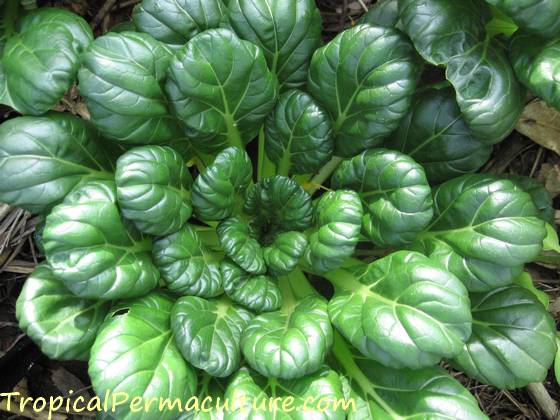 The tropical vegetable tatsoi. The delicious salad green can also be used in cooking.
The tropical vegetable tatsoi. The delicious salad green can also be used in cooking.I tried to grow English spinach and cauliflowers, and continental cucumbers and hearting lettuces...
And everything bolted to seed or was devoured by bugs or simply rotted from the roots or the centre!
One reader facing a similar predicament wrote, "Do you find summer insect attack lessens after the soil improves, or is it just the way things are?"
Growing Vegetables In Hot Weather
There will always be more insects in a tropical climate than in a cool climate, that's for sure! But in a balanced environment there will be more beneficial insects or "good bugs", too.
Better soil certainly does make your vegetables less susceptible to insects and diseases. Happy plants don't get sick and don't attract as many pests. But that's not the whole story.
Some plants, like cauliflowers or lettuce for example, they just don't like heat. Most Mediterranean plants including tomatoes, they can't stand humidity.
If it's too hot or too humid for them then plants stress. And if they stress they attract bugs, just like people attract colds and flus when they are stressed out and run down.
Insects can smell the stress. Really. Stressed plants do emit substances the insects can detect.
The bugs are a symptom, not the core of the problem, and good soil can only do so much. It means the plants will withstand the heat a bit longer, but sooner or later the heat will get to them...
So you can support your vegetables with a combination of good, deep soil, regular moisture and planting them in the right position. Forget what your English gardening book preaches about full sun. Plan ahead so that once it gets hot there will be something shading the more sensitive plants.
But the best thing to do during hot weather is to grow tropical vegetables. Grow vegetables that like heat! You won't find an eggplant troubled by bugs just because it gets hot. (Unfortunately I can't stand eggplant.)
That's what permaculture is about, working with nature, not against it. Trying to grow unsuitable plants makes life unnecessarily difficult. Growing tropical vegetable varieties instead makes life easy.
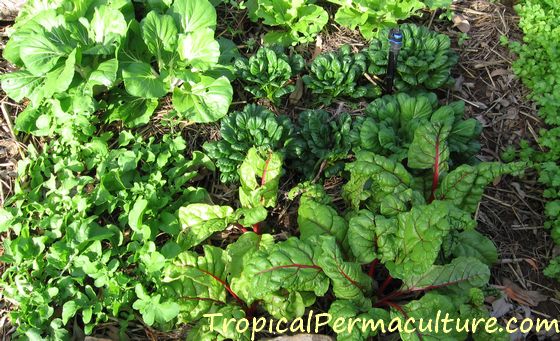 Arugula/rocket, Chinese cabbages, chard/silverbeet, tatsoi, and some cilantro on the far right.
Arugula/rocket, Chinese cabbages, chard/silverbeet, tatsoi, and some cilantro on the far right.Grow Tropical Vegetables
- Tomatoes will grow well during the winter/dry season, but do look for heat tolerant varieties so they last as long as possible. Cherry tomatoes are a lot hardier than the larger varieties.
(Cherry tomatoes self seed in my garden and every now and then I will find a bonus bush that has been sheltered and shaded by some bigger shrub and is loaded with fruit, in the middle of a tropical summer!) - Even in the tropical equivalent to winter, the dry season, the hearting lettuce varieties are a lost cause. Don't bother with them. In hot climates you should only grow the open leafed kind.
Amongst the open leafed lettuces the oak leaf varieties are the most heat resistent, cos varieties the least.
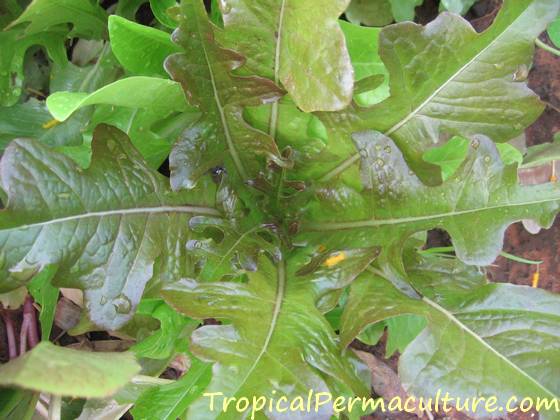 Oak leaf lettuce is better suited to the tropics.
Oak leaf lettuce is better suited to the tropics.- There are a variety of plants that are touted as tropical lettuce substitutes, and I find them all horrible:
Ceylon spinach, ibika, salad mallow... They taste ok. The problem with them is that they are all rather glutinous. (Slimy, to say it as it is.) - I love all the different Asian Greens or Chinese cabbages. There are dozens of varieties that all belong to the cabbage family, and like standard cabbage they can be eaten both fresh or cooked.
Some are hearting and have the same problems as hearting lettuces, though they do last longer. Others you grow for the unopened flower heads (Asian broccolis) and some are open leafed. They withstand heat a lot better than our lettuce. Mizuna, mibuna, tatsoi, wong bok, bok choi... There is something for everyone.
By the way, mustard greens and rocket/arugula also belong in this family and grow well in hot weather.
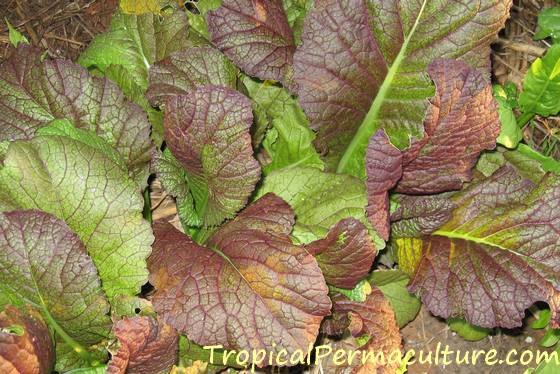 Purple mustard
Purple mustard- I grow a wonderful Asian cucumber variety called "Suyo Long". Tastes exactly like the continental cucumbers, only it's a bit hairy so you have to scrub it if you want to eat it with the skin. But it sure doesn't mind hot weather and is a prolific bearer. It beats any other cucumber I ever tried.
- Angled luffa (or loofah) is a climber and a great zucchini substitute during the humid summer/wet season (when zucchinis get too many problems with bugs and mildew).
- Eggplants, chillies and peppers/capsicums will grow well no matter how hot it gets. So will sweet corn.
- Grow tropical shallots (taste just like European shallots) instead of onions. It means you have to peel stacks of little onions every time you want to cook a meal, but at least they grow.
Instead of garlic grow garlic chives. Instead of real chives also grow garlic chives. - Some tropical vegetables grow so well once the summer rains start, they become a menace and try to take over your garden. Never turn your back on sweet potatoes during the summer/wet season. Also keep an eye on kang kong and amaranth and salad mallow.
- All the starchy tubers that are staples in tropical countries grow well in real hot and humid summers: yams, taro, cassava...
(Rice would grow well, too, but harvesting and cleaning it is tedious work. I never tried it and don't know anything about it.) - French beans don't even like my winters, but the tropical beans like snake beans and winged beans grow just fine during tropical summers. So do many of the beans that are grown as cover crops: mung beans, soy beans, cow peas... Tried to grow peanuts? They're a legume, too.
- Pumpkins will grow if you can stay on top of the pumpkin beetles and mildew.
I hope this gives you some ideas and inspiration. Now that I work with my climate rather than against it, I find growing tropical vegetable gardens much easier than growing anything in Europe. In the tropics I can grow all the vegetables I need, all year round.
Sure, there are things I miss and still buy (Garlic! And Lindt chocolate.) But mostly I have adapted my cooking and diet to where I live. Growing tropical vegetables makes sense and it makes the tropical gardeners life easy.
I can still grow, cook and eat many of my European favourites during winter. And during summer there will be more of the wonderful exotic and Asian dishes on the menu.
A-Z List Of Warm Climate And Tropical Vegetables
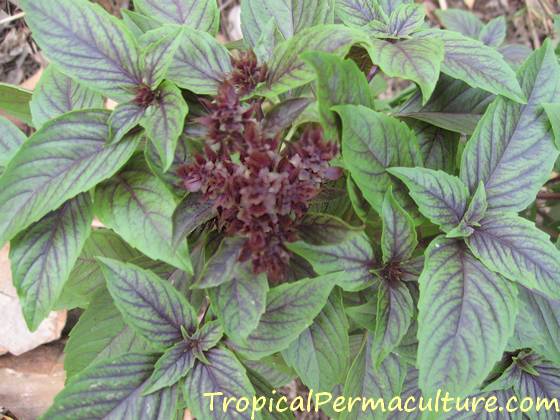 Thai basil goes well with your tropical vegetables, both in the garden and in the kitchen.
Thai basil goes well with your tropical vegetables, both in the garden and in the kitchen.- Amaranth (use leaf amaranth like spinach)
- Arugula (rocket)
- Asian Greens (mizuna, mibuna, tatsoi, wong bok, bok choi...)
- Beans (try snake beans and winged beans in the tropics)
- Bell Peppers/Capsicums
- Cassava (starchy tubers)
- Ceylon Spinach
- Chard (silverbeet, similar to spinach)
- Chinese Cabbages
- Chilli Peppers
- Cucumbers (tropical varieties, Suyo Long is a variety I had great success with)
- Eggplant (aubergine)
- Endive
- Kang Kong (water spinach)
- Lettuce (open leafed, esp. oak leaf viarieties)
- Luffa (angled luffa is a great zucchini substitute)
- Okra
- Peppers
- Pumpkins
- Radish
- Rocket (arugula)
- Silverbeet (chard, similar to spinach)
- Squash
- Sweet Corn
- Sweet Potatoes (instead of normal potatoes)
- Tomatoes (look for heat tolerant varieties, cherry tomatoes are hardier)
- Water Chestnuts
- Zucchini